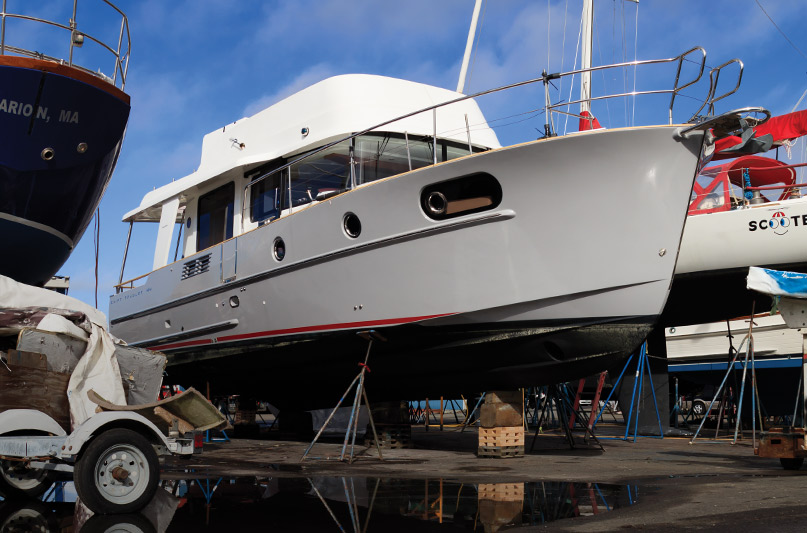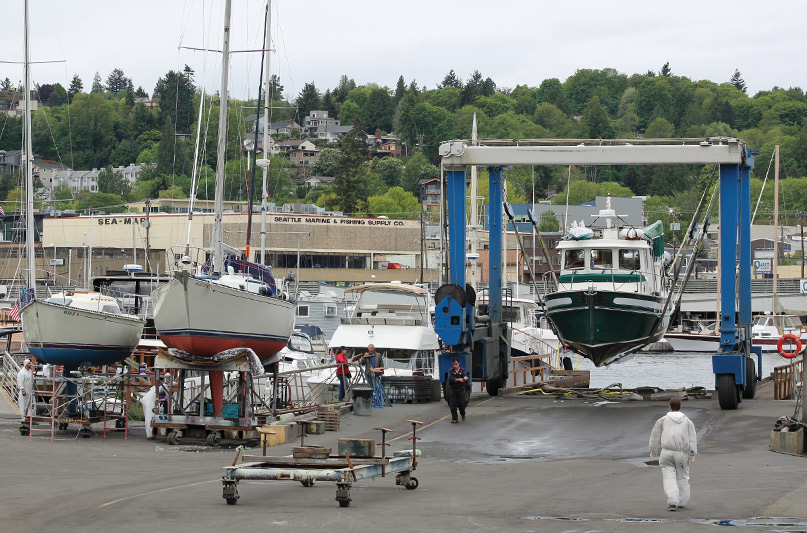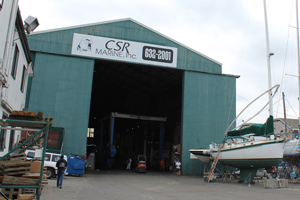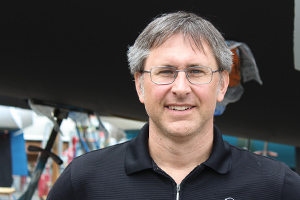
“Every act of creation is first an act of destruction.”
—Pablo Picasso
The days of summer may be lengthening and the memories of last winter’s Seattle Boat Show fading, but now is a time of excitement for those of us lucky enough to take the plunge and put ink on a new boat from the event. A few months have passed since the excited handshake between new owner and seasoned broker, and the boat is set to arrive any day, just in time to enjoy the summer!
But wait, the broker says, we still must commission. We absorb the news. It’ll be six weeks after the boat arrives to the yard until we get to turn the key and leave the dock for the first time.
“Six weeks?! Why can’t I just take it off the truck and GO?” we want to shout, that upcoming salmon opener or sailboat regatta glaring at us from the calendar. Although the let’s-go attitude will serve us well as boaters, commissioning a new boat is a critical step that mustn’t be shortcutted. With exception of a few companies, all new boats are shipped in a semi-completed state and require professional craftspeople to assemble properly. What’s more, all those great custom options we meticulously opted for are often locally sourced and installed during the commission process as well.
What does the commission of a new boat look like? How involved should we be as customers in the process? For the sake of the new owners eyeing the 2018 season as well as the dreamers, we sat down with Nigel Barron of CSR Marine Services in the Ballard neighborhood of Seattle, Washington. Barron and the company have decades of experience working with brokers and boaters across the region to commission all manner of new boats from power to sail. We were lucky enough to catch him between the many projects he juggles during the busy season.
NWY: Let’s start at step one; a person buys a new boat for the first time and is new to the commissioning process. Can you walk us through the process and explain what it is exactly?
Certainly. First off, commissioning a new boat is a symbiotic partnership between broker, who is paying for the invoice, and boatyard. We [CSR] commission a lot of new boats every year, exclusively for some dealers. Whether we’re talking about sail or power boats, they all come in the same way; partially completed. There’s a few brands that are sending over complete builds, but obviously it’s very hard to ship a completed sailboat because you have to ship the mast. The process depends on sail vs. power.
It also depends on where the boat is coming from. Many Jeanneau and Beneteau sailboats are built in South Carolina, for example. Formula is built in Wisconsin, Catalinas in Florida. Many boats are built in Europe or Asia. The process depends on where the boat is coming from, and the big factor is if the boat is coming with the keel on or off. Consequently, the rudders are on or off. For the most part, boats coming from abroad like Europe are coming with the keel off because it’s easier to transport the boat on the cradles that way. We just offloaded a Beneteau like that today; just came off the truck.
The typical process is that the boat arrives, and the dealer, whoever sold the boat or is bringing it in for stock, is paying the truck driver. The dealer always inspects the boat on the truck before they offload it to make sure there’s no shipping damage, damage to the mast, hull, etc.
NWY: Is the boat’s arrival on the truck and the commissioning process a sort of checkpoint? Does it bring together the various players in a given boat deal (broker, client, etc.)?
Yes, and typically dealers do it one of two ways. Some keep their customers fully engaged by telling them when the boat is coming into the yard and invites them to watch the unloading process.
The other way follows the ‘you don’t want to know how sausages are made’ philosophy. Dealers may want the customers to just see the finished product. In other words, a dealer may want to make sure that there’s no damage when the customer sees the build for the first time. We had a boat come in one time when there was four inches of snow on the ground. Turns out, the snow was the difference between the boat going under the bridge and hitting the bridge. The boat came in with all the cabintop winches and everything sheared off at 60 mph going down the freeway. Stories like that makes dealers nervous about showing off the newly arrived build to the customer right away.
Upon arrival on the truck, the dealer will go through their checklist because they need to make any necessary notes on the bill of lading. If there are shipping damages that are not noted on the bill of lading, the driver can just claim that it wasn’t on the bill of lading and get off the hook.
So, if there are problems, the dealers note it and we get on it quickly to repair it. Part of that whole sausages-is-made thing, these newly arrived boats are partially completed. We have a lot of local options that need to be installed on the boat and a lot of stuff gets added after the fact by the customer. We’re checking all the cabinetry and the floor, making sure the bilge is looking good, making sure the hull didn’t hit a bump on the road too hard, that kind of thing. Boats are really opened up here in the yard, and for some people that can be traumatizing to witness.
Other people, and I honestly prefer these people, see commissioning as an opportunity to see how sausages are made. They want to see the guts of their boat, where a fuse box is or where a through hole is hidden.
NWY: The commissioning process does seem like a perfect time to see the new boat in a way that an owner may never get to again. Is that fair to say?
Exactly. For example, components are glued in place and you may not get to see how the different pieces go together again. A lot of people don’t explore all the available dead space behind the cushions once they’re down. There’s often a lot of stowage that owners aren’t aware of for years just because it’s hidden behind a cushion they didn’t lift up.
After that, if it’s a sailboat, there’s a mast to assemble. Masts come in essentially a tube and we build the furler, run the shrouds, run the wires, install the radar, spreaders, lights, get it stepped, splash it, check it, and the like. All these boats are supposed to be run at the factory, but you never really know, so we put it in the water. We check the fluid levels and run everything.
NWY: Is the philosophy to not assume anything? Do you primarily rely on your own in-house standard operating procedures the most?
We do the same checklist for every boat, but it’s hard to go all the way and say that we assume nothing. We meet the manufacturer part way and at some point, you have to work off the base assumption that the factory built a working boat. We’re not going to start drilling core samples to see if the fiberglass lay-up schedule is right. We’re going to check all the systems, but we’re not going to check to see if something is loomed correctly, as-built vs. as-intended.
There’s a saying that production boats have production problems and custom boats have custom problems. You want to trust but verify. At some point, you have to make base assumptions that what you’re dealing with is how the manufacturer, dealer, and customer want to do it.
NWY: Is there a clearly defined umbrella of responsibility when it comes to a boatyard during a commissioning? Between the customer, dealer, manufacturer, transportation companies, etc., there seems like there could be a lot of cooks in the kitchen.
Right, that’s part of the reason why we rely on a clear checklist for boats. If there is a variance from the list, we can go to the broker and say hey, “x and y is going to take z to fix,” then they can go back to the factory for approval to see if this is what they want.
We almost always find stuff when we go through these boats, a hose that isn’t hooked up or is nicked or something. When that happens, when we pressurize the water system, we hear the pumps cycling, so then we got to go track down the leak. Maybe something is screwy with the electronics after they are installed, and we have to troubleshoot the electronics. It’s all driven by the broker, because ultimately they are the ones paying the invoice. Commissioning for the most part is just done on a for-foot basis to make it easy.
NWY: It sounds like the broker typically does the face-to-face with you [the boatyard] more so than the buyer. Is that usually the case?
Yes, we deal with the broker more so than directly with the client during new boat commissioning. Sometimes there are a lot of add-ons. For example, we have a Beneteau 48 coming in and the buyers want a lot of options that are going to get taken care of during commissioning. We’re scheduling a meeting with the owners to discuss where they want the TV mounted, where they want the additional lights and outlets placed in the interior, where do they want those extra hatches included, etc. For owner-driven features, we get the owner involved. A broker is not going to own making an aesthetic decision for the customer, and neither do we.
Q: NWY: Do a lot of owners continue to use the same boatyard after the commissioning for re-commissioning or maintenance, or is it typically bon voyage?
For a lot of the stuff we do, the intent is that all the boat needs at the end of it is food and fuel and it can sail or power away. When we’re done, the dealers take it and comb over it with another one of their checklists. There are usually local options outside of the boatyard to account for as well, like special pillows or detailing at their docks. The dealer still has a laundry list to do after we’re done with it.
We figure that it’s a two- or three-week process getting a new boat off the truck and commissioned through the yard and picked up by the broker. Usually the broker wants at least a week or two before handing it over, 100 percent ready to go, to the customer. The brokers usually tell their customers that their boat will be ready for them five or six weeks after arrival to the yard.
NWY: Do you have anything to say directly to brokers? What makes a broker easy to work with?
I gotta be careful here (laughs). On our end, it’s easy to tell which brokers sell more new boats than the others. These brokers have a more refined process. They come prepared with their own detailed checklist, for example. The best sailboat brokers are physically unwrapping the mast so they can inspect it to make sure there’s no abrasion spots or blemishes that might not have anything to do with trucking, but could be how the mast was anodized. Another example is that most boats coming in from Europe are shrink-wrapped. Ace brokers will remove the shrink wrap themselves and thoroughly inspect the boat right away.
Being hands-on like this helps the brokers determine the source of any problems or damage, like whether it was a shipping accident or a factory mistake. Did the factory ship the rudder on the high gloss table, where the rudder banged around and scuffed it up on the truck ride? If that’s the case, that’s not really on the trucker, it’s on the guys that packed the boat up for shipping at the factory that messed up.
NWY: I bet the truckers get thrown under the bus a lot.
A ton and it’s often undeserved. That’s why the good brokers inspect the boat while it’s on the truck. If the mast of a sailboat on the truck is supported a certain way, but the damage to the mast is elsewhere, then the damaged mast really has nothing to do with the trucker. It’s wise to take a photograph to help piece it together.
NWY: Do you recommend that customers check out their broker’s yard ahead of time? How much hands-on attention is too much?
Yes and no. Yes, it’s always good to scope out the yard ahead of time if you can. However, the value of a good broker is taking advantage of that local knowledge and expertise. A good broker also should have a network of contacts all over the place, like both coasts, with colleagues that can recommend good yards. Boaters use brokers so they can rely on their expertise, so minimal boatyard research should be warranted. You shouldn’t have to be looking on the internet for the best yards. Brokers are professionals and should prove their worth to their clients, especially during the commissioning process.
NWY: Do people usually survey a newly commissioned boat, or is that sort of superfluous?
Not really because there is an assumption of a warranty. There shouldn’t be a reason to get a survey for a new boat. If there is a problem when you go out in a new boat, you should be covered. A great notable example of customer service is Signature Yachts who offer a six-month checkup to take care of the little things, cracked gelcoat and the like.
The broker-boatyard relationship is supposed to be symbiotic; when the brokers are doing well, we’re doing well. When we’re doing well, the brokers are happy. It requires everyone to do their jobs and then everyone is happy. The system works. Sometimes you get customers who you have to walk back a little bit. Yes, there is a crack. We’re going to repair it in four hours. And you know what? You will find other ones. It’s not the end of the world, everything can be fixed.

NWY: Local options are a part of just about any new boat coming into the Pacific Northwest. We have a lot of local talent around here; what do you see a lot of in terms of local options?
Probably the number one local option is heat. A lot of boats not from around here will have the reverse cycle air conditioning, which isn’t generally enough for a cruise up to Alaska. If you’re in San Diego or Florida, heating isn’t probably on your list of necessities. The problem with those reverse cycles is that they are great for the air conditioning, but not for heating. Even boats that have it installed at the factory will still have a heater installed as a local option, like a Webasto hydronic or forced air system.
Probably a close second to heating is chain. Most of the boats coming in here have 35’ of chain, which is perfectly fine if you’re on the Chesapeake or Tampa Bay where it’s nine feet deep. We almost always have to take out the 35’ of chain on a new boat and put in 150’ feet of chain and 150’ of rode. So that’s probably closely tied with the heater for local options.
Some of the larger boats opt for a watermaker or secondary fuel tank because of Alaskan cruising ambitions. But the two most common local options are heating systems and chain, practical stuff. There are not a lot of places in Puget Sound where 35’ of chain is adequate, usually you’re in 35’ of water! We’re in the Pacific Northwest, not Florida or the Chesapeake.

